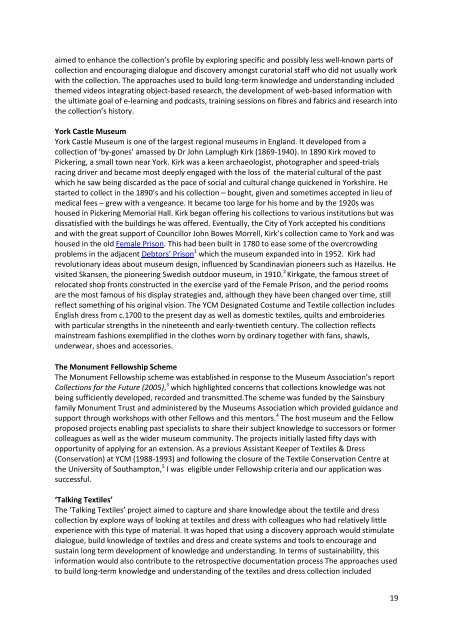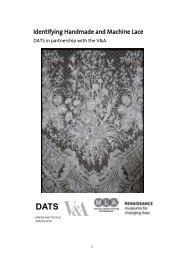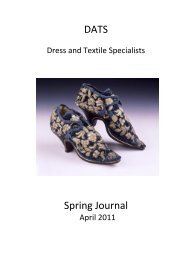Spring 2012 - Dress and Textile Specialists
Spring 2012 - Dress and Textile Specialists
Spring 2012 - Dress and Textile Specialists
Create successful ePaper yourself
Turn your PDF publications into a flip-book with our unique Google optimized e-Paper software.
aimed to enhance the collection’s profile by exploring specific <strong>and</strong> possibly less well-known parts of<br />
collection <strong>and</strong> encouraging dialogue <strong>and</strong> discovery amongst curatorial staff who did not usually work<br />
with the collection. The approaches used to build long-term knowledge <strong>and</strong> underst<strong>and</strong>ing included<br />
themed videos integrating object-based research, the development of web-based information with<br />
the ultimate goal of e-learning <strong>and</strong> podcasts, training sessions on fibres <strong>and</strong> fabrics <strong>and</strong> research into<br />
the collection’s history.<br />
York Castle Museum<br />
York Castle Museum is one of the largest regional museums in Engl<strong>and</strong>. It developed from a<br />
collection of ‘by-gones’ amassed by Dr John Lamplugh Kirk (1869-1940). In 1890 Kirk moved to<br />
Pickering, a small town near York. Kirk was a keen archaeologist, photographer <strong>and</strong> speed-trials<br />
racing driver <strong>and</strong> became most deeply engaged with the loss of the material cultural of the past<br />
which he saw being discarded as the pace of social <strong>and</strong> cultural change quickened in Yorkshire. He<br />
started to collect in the 1890’s <strong>and</strong> his collection – bought, given <strong>and</strong> sometimes accepted in lieu of<br />
medical fees – grew with a vengeance. It became too large for his home <strong>and</strong> by the 1920s was<br />
housed in Pickering Memorial Hall. Kirk began offering his collections to various institutions but was<br />
dissatisfied with the buildings he was offered. Eventually, the City of York accepted his conditions<br />
<strong>and</strong> with the great support of Councillor John Bowes Morrell, Kirk’s collection came to York <strong>and</strong> was<br />
housed in the old Female Prison. This had been built in 1780 to ease some of the overcrowding<br />
problems in the adjacent Debtors’ Prison 1 which the museum exp<strong>and</strong>ed into in 1952. Kirk had<br />
revolutionary ideas about museum design, influenced by Sc<strong>and</strong>inavian pioneers such as Hazeilus. He<br />
visited Skansen, the pioneering Swedish outdoor museum, in 1910. 2 Kirkgate, the famous street of<br />
relocated shop fronts constructed in the exercise yard of the Female Prison, <strong>and</strong> the period rooms<br />
are the most famous of his display strategies <strong>and</strong>, although they have been changed over time, still<br />
reflect something of his original vision. The YCM Designated Costume <strong>and</strong> <strong>Textile</strong> collection includes<br />
English dress from c.1700 to the present day as well as domestic textiles, quilts <strong>and</strong> embroideries<br />
with particular strengths in the nineteenth <strong>and</strong> early-twentieth century. The collection reflects<br />
mainstream fashions exemplified in the clothes worn by ordinary together with fans, shawls,<br />
underwear, shoes <strong>and</strong> accessories.<br />
The Monument Fellowship Scheme<br />
The Monument Fellowship scheme was established in response to the Museum Association’s report<br />
Collections for the Future (2005), 3 which highlighted concerns that collections knowledge was not<br />
being sufficiently developed, recorded <strong>and</strong> transmitted.The scheme was funded by the Sainsbury<br />
family Monument Trust <strong>and</strong> administered by the Museums Association which provided guidance <strong>and</strong><br />
support through workshops with other Fellows <strong>and</strong> this mentors. 4 The host museum <strong>and</strong> the Fellow<br />
proposed projects enabling past specialists to share their subject knowledge to successors or former<br />
colleagues as well as the wider museum community. The projects initially lasted fifty days with<br />
opportunity of applying for an extension. As a previous Assistant Keeper of <strong>Textile</strong>s & <strong>Dress</strong><br />
(Conservation) at YCM (1988-1993) <strong>and</strong> following the closure of the <strong>Textile</strong> Conservation Centre at<br />
the University of Southampton, 5 I was eligible under Fellowship criteria <strong>and</strong> our application was<br />
successful.<br />
‘Talking <strong>Textile</strong>s’<br />
The ‘Talking <strong>Textile</strong>s’ project aimed to capture <strong>and</strong> share knowledge about the textile <strong>and</strong> dress<br />
collection by explore ways of looking at textiles <strong>and</strong> dress with colleagues who had relatively little<br />
experience with this type of material. It was hoped that using a discovery approach would stimulate<br />
dialogue, build knowledge of textiles <strong>and</strong> dress <strong>and</strong> create systems <strong>and</strong> tools to encourage <strong>and</strong><br />
sustain long term development of knowledge <strong>and</strong> underst<strong>and</strong>ing. In terms of sustainability, this<br />
information would also contribute to the retrospective documentation process The approaches used<br />
to build long-term knowledge <strong>and</strong> underst<strong>and</strong>ing of the textiles <strong>and</strong> dress collection included<br />
19





